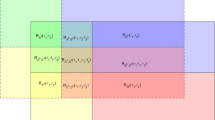Abstract
In this paper, we consider the multi-group multicasting problem in a MIMO wireless cellular system, whereby the base station can generate multiple beampatterns to serve multiple groups simultaneously. Each user is interested in multiple multicast groups, but is only allowed to be assigned to one of them eventually during each transmission interval. We formulate it as a joint optimization problem of multicast beamformer design as well as user grouping, and admission control is also considered to account for the quality of service demands of individual users. To deal with this NP-hard problem, we adopt the big-M formulation method and the semidefinite relaxation scheme to reformulate it to a mixed-integer semidefinite programming problem. Three algorithms are developed to solve the obtained approximate problem with different computational costs. Simulation results are presented to demonstrate the performance of the proposed algorithms in terms of the number of admitted users, power consumption and computation time.







Similar content being viewed by others
Notes
If the solution of matrix \(\mathbf {W}_l\) is rank one, we can directly apply eigenvalue decomposition to obtain the optimum beamforming vector \(\mathbf {w}_l\). Otherwise, \(\mathbf {w}_l\) can be determined using a randomization method [9, 12]. Due to space limitation, we do not illustrate the detailed steps in the following developed algorithms.
References
Hu, B., Hua, C., Chen, C., & Guan, X. (2014). Transmit beamforming and admission control for multicast with uncertain user partition. In Proceedings of IEEE/CIC International Conference Communications in China (ICCC) (pp. 16–20).
Cisco Visual Networking Index: Global Mobile Data Traffic Forecast Update, 2015–2020 White Paper. http://www.cisco.com/c/en/us/solutions/collateral/service-provider/visual-networking-index-vni/mobile-white-paper-c11-520862.html.
Lecompte, D., & Gabin, F. (2012). Evolved multimedia broadcast/multicast service (eMBMS) in LTE-advanced: overview and Rel-11 enhancements. IEEE Communications Magazine, 50(11), 68–74.
Verizon Delivers LTE Multicast Over Commercial 4G LTE Network in Indy. https://www.verizonwireless.com/news/article/2014/05/verizon-wireless-lte-multicast.html.
AT&T to build LTE-Broadcast network for video. http://www.usatoday.com/story/tech/2013/09/25/att-lte-broadcastnetwork-video/2867475/.
Zhao, N., Yu, F. R., & Leung, V. C. M. (2015). Opportunistic communications in interference alignment networks with wireless power transfer. IEEE Wireless Communications, 22(1), 88–95.
Zhao, N., Yu, F. R., Sun, H., & Li, M. (2016). Adaptive power allocation schemes for spectrum sharing in interference-alignment-based cognitive radio networks. IEEE Transactions on Vehicular Technology, 65(5), 3700–3714.
Sidiropoulos, N. D., Davidson, T. N., & Luo, Z.-Q. (2006). Transmit beamforming for physical-layer multicasting. IEEE Transactions on Signal Processing, 54(6), 2239–2251.
Karipidis, E., Sidiropoulos, N. D., & Luo, Z. Q. (2008). Quality of service and max-min fair transmit beamforming to multiple cochannel multicast groups. IEEE Transactions on Signal Processing, 56(3), 1268–1279.
Christopoulos, D., Chatzinotas, S., & Ottersten, B. (2014). Weighted fair multicast multigroup beamforming under per-antenna power constraints. IEEE Transactions on Signal Processing, 62(19), 5132–5142.
Luo, Z.-Q., Ma, W.-K., So, A. M.-C., Ye, Y., & Zhang, S. (2010). Semidefinite relaxation of quadratic optimization problems. IEEE Signal Processing Magazine, 27(3), 20–34.
Xiang, Z., Tao, M., & Wang, X. (2013). Coordinated multicast beamforming in multicell networks. IEEE Transactions on Wireless Communications, 12(1), 12–21.
Karipidis, E., Sidiropoulos, & N., Tassiulas, L. (2008). Joint QoS multicast power/admission control and base station assignment: A geometric programming approach. In Proceedings of IEEE Sensor Array and Multichannel Signal Processing Workshop (SAM) (pp. 155–159).
Matskani, E., Sidiropoulos, N. D., Luo, Z. Q., & Tassiulas, L. (2009). Efficient batch and adaptive approximation algorithms for joint multicast beamforming and admission control. IEEE Transactions on Signal Processing, 57(12), 4882–4894.
Kim, T. O., Devanarayana, C. N., Alfa, A. S., & Choi, B. D. (2015). An optimal admission control protocol for heterogeneous multicast streaming services. IEEE Transactions on Communications, 63(6), 2346–2359.
Zhou, H., & Tao, M. (2015). Joint multicast beamforming and user grouping in massive MIMO systems. In Proceedings of IEEE International Conference Communications (ICC) (pp. 1770–1775).
Cheng, Y., Pesavento, M., & Philipp, A. (2013). Joint network optimization and downlink beamforming for CoMP transmissions using mixed integer conic programming. IEEE Transactions on Signal Processing, 61(16), 3972–3987.
Colson, B., & Marcotte, P. (2007). An overview of bilevel optimization. Annals of Operations Research, 153(1), 235–256.
Vecchietti, A., Lee, S., & Grossmann, I. E. (2003). Modeling of discrete/continuous optimization problems: characterization and formulation of disjunctions and their relaxations. Computers and Chemical Engineering, 27(3), 433–448.
Hua, C., & Zheng, R. (2012). Robust topology engineering in multiradio multichannel wireless networks. IEEE Transactions on Mobile Computing, 11(3), 492–503.
Ye, Y. (1997). Interior point algorithms: Theory and analysis. New York: Wiley.
CVX: Matlab software for disciplined convex programming, version 2.1. http://cvxr.com/cvx.
Acknowledgements
The original version of this paper was presented at IEEE/CIC ICCC 2014 [1]. This work was supported in part by National High Technology Research and Development Program of China (863 Program) (No. 2015AA01A702), and by the NSF of China under the Grants 61371085, 61431008, 61221003, U1405251, 61290322 and 61273181.
Author information
Authors and Affiliations
Corresponding author
Appendix
Appendix
1.1 Proof of Lemma 1
In this section, we prove that under the condition \(0<\rho <\frac{1}{P_{\text{max}}}\), the single-stage problem in (7) is equivalent to the two-stage problems in (5) and (6) in terms of achieving the maximum subset of admitted users. In addition, it can automatically obtain the maximum subset with the minimum transmit power.
Assume the optimal solution of problem (7) is \(\{\mathcal{U}_l^\star ,\mathbf {w}_l^\star \}_{l \in \mathcal{L}}\) and define the maximum subset of admitted users is U. Then the optimal objective of problem (5) is U if only if the optimal objective of problem (7) is lies in \((U-1,U)\). In addition, if the maximum admissible set of the system is \(\{\mathcal{U}_l^\star \}_{l \in \mathcal{L}}\), the minimum transmit power for the admitted users is \(P_{\text{cost}}\triangleq \sum _{l \in \mathcal{L}} \Vert \mathbf {w}_l^*\Vert _2^2\).
Firstly, we demonstrate that when the optimal objective of problem (7) is lies in \((U-1,U)\), then the optimal objective of problem (5) is U. According to the total power constraint (7b) and the parameter constraint (9), we have:
which means that the second term of the objective function in (7) cannot exceed 1, in spite of the beamforming vectors. Therefore, we can see that if the optimal objective of the problem (7) is lies in \((U-1,U)\), then the optimal objective of problem (5) is U.
Then, we show that if the optimal objective of problem (5) is U, the one-stage problem (7) is capable of achieving the maximum admissible set, i.e., the optimal objective of problem (7) is lies in \((U-1,U)\). The proof is executed by contradiction. Suppose \(\{\widehat{\mathcal{U}}_l,\widehat{\mathbf {w}}_l\}_{l \in \mathcal{L}}\) is a feasible solution of problem (7), where \(\sum _{l \in \mathcal{L}}|\widehat{\mathcal{U}}_l|=U\). Assume the optimal solution of problem (7) is \(\sum _{l \in \mathcal{L}} |\mathcal{U}_l^*|<U\), we have:
wherein the first inequality is obtained by the fact that the number of admitted users is discontinuous with an increment of 1. It can be seen that this result is contradict to the assumption that \(\{\mathcal{U}_l^*,\mathbf {w}_l^*\}_{l \in \mathcal{L}}\) is the global optimum of problem (7). Therefore, when the optimal objective of problem (5) is U, the solution of problem (7) can be achieved with the suitable beamforming vectors such that U users are served, that is, the objective of problem (7) lies between \(U-1\) and U.
Finally, we show the fact that if the maximum subset of admitted users has multiple solutions, the achieved solution of problem (7) requires the minimum transmit power. The reason is that when the first term of objective function in (7) is a constant, the second term possess the effect of selecting the one of admitted set from the candidate multiple maximum admission sets with the minimum transmit power. Therefore, the proof of Lemma 1 is completed.
1.2 Proof of Lemma 2
Equation (13a) contains multiple-choice constraint corresponding to the binary variables \(\eta _l^k,\forall l,k\), so we proof this lemma from the following conditions.
Firstly, if \(\eta _l^k=1\), the constraint (13a) is equivalent to
which is the same as Eq. (10a) in this case.
Secondly, if \(\eta _l^k=0\), the constraint (13a) is given as
The left-hand side of (20) can be rewritten as:
where the second inequality is obtained according to the Cauchy–Schwarz inequality. Therefore, Eq. (13a) is satisfied automatically when we set the values of \(M_k\)s according to Lemma 2 in this case.
Based on the above analysis, the constraint in (13a) is equivalent to the constraint in (10a) if only if \(M_k\) satisfies the condition (14).
Rights and permissions
About this article
Cite this article
Hu, B., Hua, C., Chen, C. et al. User grouping and admission control for multi-group multicast beamforming in MIMO systems. Wireless Netw 24, 2851–2866 (2018). https://doi.org/10.1007/s11276-017-1510-5
Published:
Issue Date:
DOI: https://doi.org/10.1007/s11276-017-1510-5




